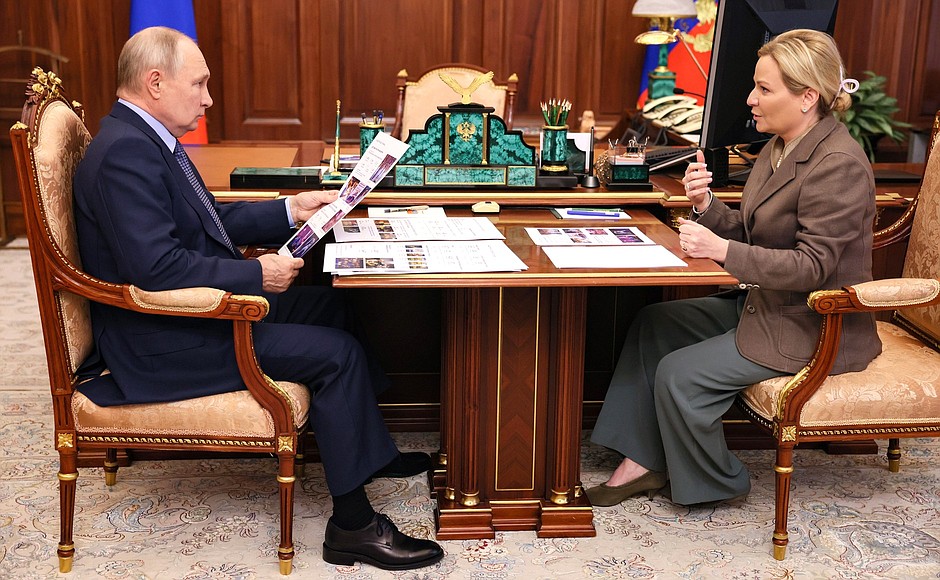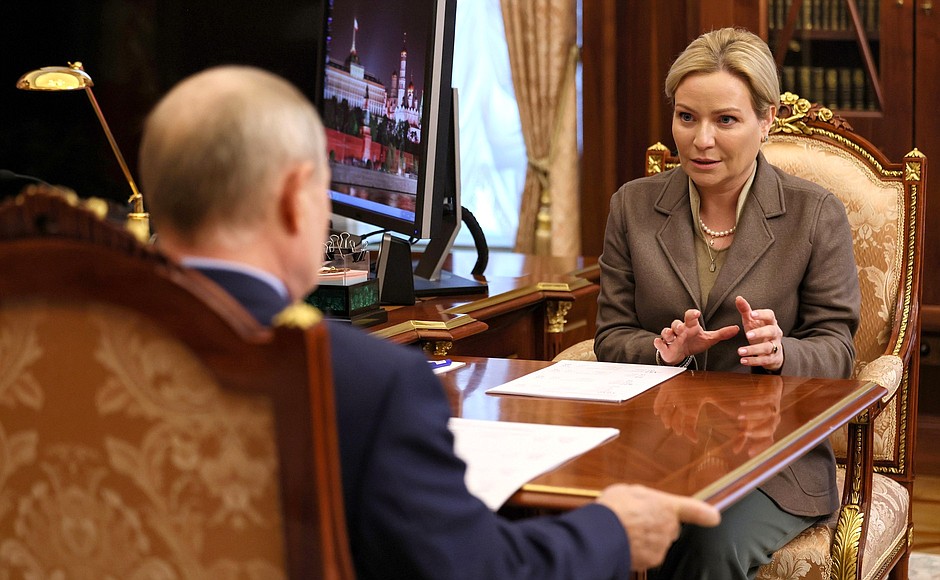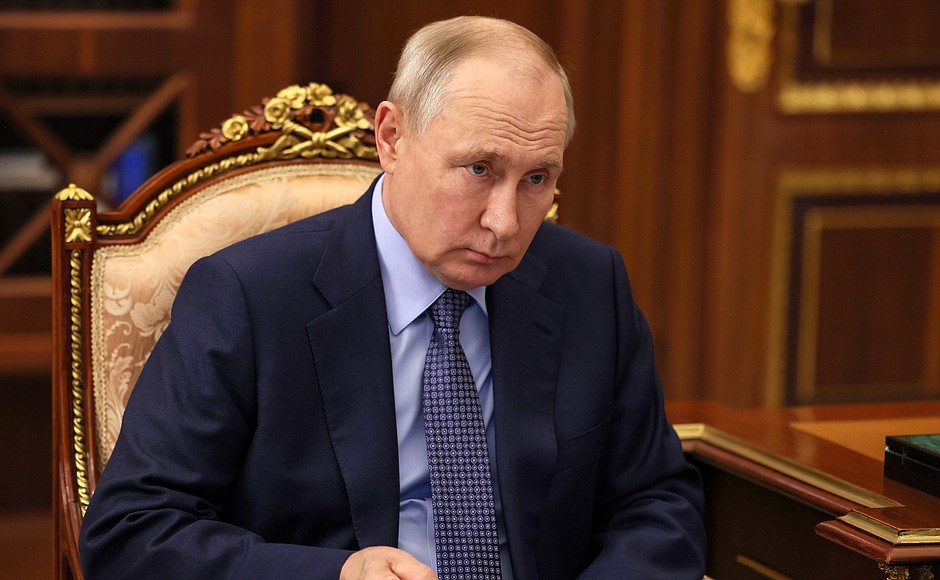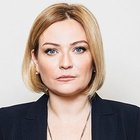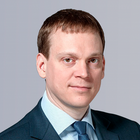President of Russia Vladimir Putin: Ms Lyubimova, let us begin with what is happening in the regions through your ministry.
Minister of Culture Olga Lyubimova: Let me start with our work in new regions.
Vladimir Putin: Please.
Olga Lyubimova: This is a new task for us. We have 13,000 new colleagues, cultural figures who have joined us: we are working well together, in a variety of areas.
We have a little more than a thousand libraries, almost a thousand cultural centers, nearly 160 children's art schools and 77 museums. In all these areas, we are beginning to work systematically in the same way as in the Culture national project: we began to work with all regions, gradually creating children’s cultural centres in libraries, museums, cultural centres; rebooting this infrastructure, making various repairs, and adding a multimedia component.
In parallel, of course, all our colleagues who work in these cultural institutions are studying with us, with federal museums and theatres that provide patronage support: modern ways to communicate with young people, tours, and a completely new presentation of material with a multimedia component, when large projectors, screens, laser pointers are used. Along with this come new techniques, so we learn together.
Our colleagues come to us; they visited Tula and Nizhny Novgorod. We meet quarterly, actually get to know each other, celebrate some successes together and discuss our plans.
When we started, there were two cinema theatres working in four regions.
Vladimir Putin: Come on…
Olga Lyubimova: This is true. Older people and young people were unable to watch any films at all.
Vladimir Putin: Two cinema theatres in four regions…
Olga Lyubimova: Yes, two cinemas in four regions. The Alexander Khanzhonkov Cinema and Television College in Shakhtyorsk where young people study to be filmmakers. However, they had no cinema of their own.
Today, the new regions have 51 cinemas, and our work includes two and even three areas. It is very important that young people and the older generation be able to watch the same films as people in the other regions. We are working on this. We discuss premieres; some films are more popular than others, of course.
At the same time, demand is always strong for classic digitalised Soviet-era films with good sound quality; Mosfilm, Gosfilmofond are helping us. When a new cinema opens, it attracts people, and families go there on weekends.
Over 70,000 people, including children who have never been to the circus before and who are celebrating with us were able to see 140 circus performances in Mariupol and Lugansk.
We have conducted almost 150 different tours, and 50 regions are involved in this process. They send their own companies and receive companies whose members were unable to go anywhere for years.
There are many exhibition projects, including regional history museums and school-level exhibition projects. We see the latter as an important part of our work together with the Ministry of Education.
(Shows presentation.) This slide shows the programme of celebrities’ work. We have 21 federal theatres that share their assets with ten theatres in the new regions. They have already donated 1,500 costumes, decorations, props and stage set equipment. Four new performances have been produced.
Our famed orchestras have contributed 120 great musical instruments. Two philharmonics have been completely equipped with musical instruments, and the Kherson Region has received a brass band. On May 9, they performed the state anthem for the first time, and they also performed wartime songs on the square; people from all age groups know these songs quite well.
Set lighting equipment is, of course, very important.
We are also working on other things necessary for the new regions in line of the Ministry of Culture’s plans. Each year, we will take 10,000 children – this year to Moscow, St Petersburg, Tula, and Kaluga – to see various cultural heritage sites, space, history, cinema, theatre, concerts, just a week-long trip to see the country. Opportunities that were completely inaccessible before are opening up, and huge vistas of work are opening up for us, which we are, of course, excited about.
Another important area that we have begun to develop in federal museums is children’s centres, so that any museum is seen not as a place where you go for the first time as school student, and the second time as an older student, and maybe take your children there once, but as a place where children constantly come, like clubs. We already have 13 such centres; at the beginning of 2024, all museums will have children's centres like this.
For example, now young people from Phanagoria, Krasnodar Territory, go to Genichesk, Kherson Region: they bring workshops and invite primary school children. This first conversation in a playful format (modelling, drawing, something accessible and understandable) about the history of the world and national culture is a great joy for families, because there is an opportunity to take a child there for the afternoon so the child can really do something, so there is an opportunity to go somewhere. This, of course, is serious and the right direction for cultural institution staff.
Vladimir Putin: I see.
Olga Lyubimova: And so, this is throughout the country. For example, you can go to Kizhi, and there a young Karelian woman, an employee of the Kizhi Museum Reserve, proudly shows girls from Donetsk how to hold a workshop. We wink at each other, and I say: “Soon you will do the same.” This is how we all do it.
All this was possible so quickly because we have been working with the other regions within the Culture national project for three years before this.
Vladimir Putin: (Citing the presentation.) “The Museum of Local Lore, opened on September 5 in the LPR by the Peterhof Museum-Reserve.”
Olga Lyubimova: Yes. Peterhof brings all this equipment, sets up ottomans, lights, and multimedia. Everyone takes responsibility: for example, the Krasnodar Region with its Phanagoria for Genichesk. Everyone has their own area.
And this is our national project. It was the experience of working in all regions that the national project provided, our infrastructure and all the features, the specifics of working with small cultural institutions (not the large federal ones, but with the smallest ones) that made it possible for the new regions to naturally integrate into the general cultural environment.
There is still a lot of work ahead. Nevertheless, the regions are very active and love the Culture national project, which, of course, we appreciate very much.
I will mention one line. By the end of 2024 we will have 72 children's theatres renovated as part of the Culture national project. The governors say this hasn’t happened, not since the 1980s, but since the 1960s. In fact, all this time these wonderful buildings, popular with the local people, they now come and say, ”We never knew that there was such a beautiful mansion here, that this was such a wonderful, comfortable hall with modern facilities.“
With respect to modern opportunities and the big projects that we are planning: we are working very closely in the Ryazan Region with Pavel Malkov's team; by the end of the year will open a large museum centre at the Ryazan Historical and Architectural Museum-Reserve. A complex, very bright and modern project, 20,000 square metres, ten exhibitions a year, nine huge exhibition halls. We are planning for 200,000 visitors a year with the children's centre, a planetarium and an eco-laboratory. There will be various pavilions related to natural science including ”Space“ and ”The Origin of the Earth.“ There are programmes for teachers from secondary and vocational schools. You can come and learn about nature in the Ryazan Region, with its great culture and heritage, and the rich Museum-Reserve foundation.
The second large project after the New Year holidays: the museum and theatre quarter ”Bakhrushin Museum“ – is in the centre of Moscow, on Paveletskaya Square. This cultural centre is 1.5 hectares of landscaped territory and 8,300 square metres of exposition area. It is a very large and outstanding project that includes our unique collection of theatre history, starting with Tsar Alexei Mikhailovich and ending with the outstanding figures of the national theatre and national stage.
I can't help but say a few words about supporting Russian cinema. You know that many people were worried about the fate of Russian cinema: how will we ever be able to live without American movies, that the Russian audience is not very fond of Russian cinema… Of course, no one can be forced to go to a film that they don't want to see, but in 2020, 42.5 million people went to see Russian films, and now, in 2023, it's 87 million. This is a very important figure and indicator for us, because we know it is impossible to force people into a cinema. It is not good to hang advertisements in the streets for some bad film that people might go to see.
And we know that this kind of availability is exactly when cinemas started to be trusted and started to be visited by the whole family, when grandparents were invited to go, when a first date takes place at a cinema. That's what we're striving for.
You also issued an instruction at the time, and there were many justified critical comments; people said there were almost no films for families and children. Three years on, the Cinema Foundation received additional funding, and we initiated major projects, primarily about our common past.
Vladimir Putin: Attendance more than doubled.
Olga Lyubimova: Yes. People were worried that cinemas would close, but the numbers have increased. Approximately 5,550 cinemas are open now, and we have merged them into another state-owned chain, although people said this was a rudimentary approach, that we didn’t need another state chain. They also said it was better to invest everything in businesses, etc. Nevertheless, the national project calls for building 200 new cinemas annually. We will have almost 1,500 cinemas by 2024, and we are compiling the most diverse repertories and interesting programmes for them.
We received another instruction from this office, that is, establishing a new children’s forum institution. St Petersburg will host the International Cultural Forum soon, and we are looking forward to it. This will include our patrons that the State Tretyakov Gallery receives each year. This very serious work lasted for three days and involved children from 89 regions and young celebrities from 13 other countries. They share their successes with us, they talk about serious issues, and they present their projects. Every region submits its own project, and with excellent Russian language proficiency. These energetic young people are dedicated to their favourite cause. This is our future, and we will be applauding them soon.
We are happy to meet with them once a year and hold the international circus festival in St Petersburg that was launched not long ago. So far, our circus performers are unable to attend the most famous circus festival in Monte Carlo, but they are happy to visit our Ciniselli Circus in St Petersburg. We strive to turn this event into a wonderful occasion for the circus community. Last time, people from 16 countries came, and 15,000 people went to the circus, it was impossible to get tickets, and the city had a great time.
I would like to say a few words about international cooperation. As per your instructions, we have started to support Russian theatres abroad. Approximately 150 Russian-language theatres in 43 countries present classic Russian masterpieces. This is a great honour for us, and this is an opportunity to support our colleagues in Abkhazia, Belarus, Kyrgyzstan, Tajikistan, Turkmenistan, Uzbekistan and South Ossetia. We choose the specific productions with them. We will be marking the Alexander Pushkin anniversary, and this year also marks the 200th birthday anniversary of Alexander Ostrovsky. This is partly how we choose our presentations. They select the most gripping and interesting productions. This year, eight countries hosted 15 performances, and we are planning to stage 30 performances in nine countries throughout 2024. This number is bound to increase. We have quite a few partners, and we are really happy to have this opportunity.
<…>
